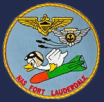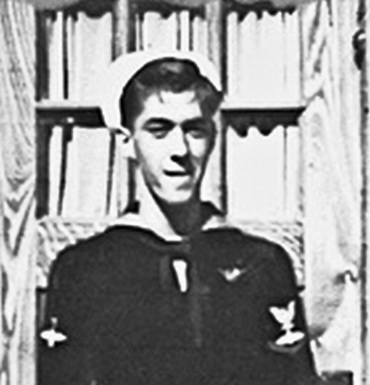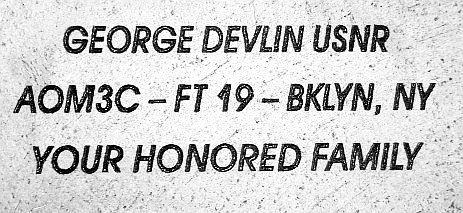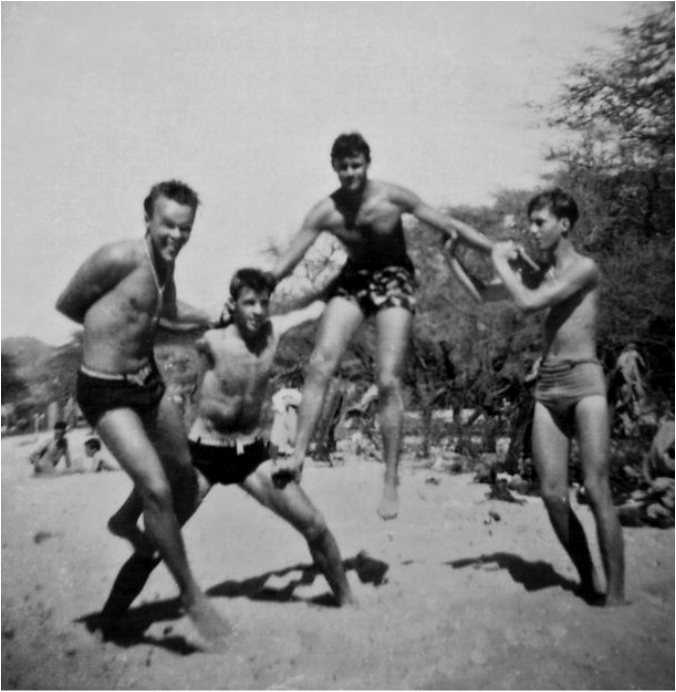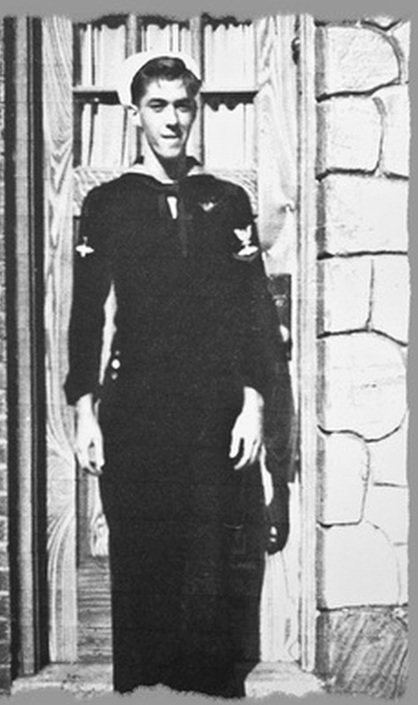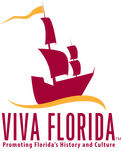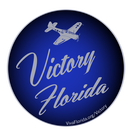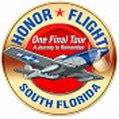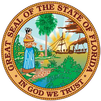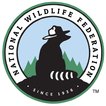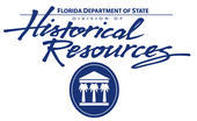George Francis Devlin, Jr.
AOM3c, USNR
Flight 19 crewman - FT-28
|
George Francis Devlin, Jr., was born in Brooklyn, New York in 1928. He was eager to help in the war effort and couldn't wait to be of age. In 1943 at the age of 15, he decided to enlist in the United States Naval Reserve, under the alias of Robert F. Harmon. George (Robert) completed training at Barber's Point Naval Air Station Hawaii in 1944, and by March 1945 he deployed to Guam and the fleet anchorage at Ulithi, where he reported on board the USS Enterprise. The war ended, and he made his way to Florida where he trained at Naval Air Station Fort Lauderdale. He was soon flying as a Gunner on the TBM/TBF Avenger Torpedo Bombers. At 17, he was in the process of having his alias changed back to his birth name, when he disappeared with Flight 19. On the fateful day of 5 December 1945 at NAS Fort Lauderdale, George (along with 13 other crewmen), was assigned to a training squadron of 5 Avenger aircraft that would be known as Flight 19. The squadron was to perform a routine navigation exercise, and mock bombing run over the Hen and Chickens shoals in the Bahamas, and then return to the NAS Fort Lauderdale. The planes never returned. Neither did a PBM Mariner rescue seaplane with 13 crewmen aboard, that was dispatched to search for their lost colleagues. In total, 6 aircraft and 27 men disappeared that afternoon. A massive search was organized, and nothing was found. Their disappearance launched one of the largest air and sea searches in history, and began the legend of the Bermuda Triangle. To this date, Flight 19 remains one of the great aviation mysteries. George Francis Devlin, Jr., was the Gunner on FT-28 piloted by Instructor Lt. Charles Carroll Taylor, USNR. The Radioman was Walter Reed Parpart, Jr., ARM3c, USNR. Aircraft was a TBM-3D with BuNo 23307. |
Memories of Devlin
|
From a letter written by William L. Smith
(Letter is not dated). "One of the men lost on Flight 19 was a crewman of mine, George Devlin. I graduated from Pensacola as a Naval Aviator February 1944 and was assigned to NAS Fort Lauderdale. Here I flew the TBM's. The Torpedo Bomber required a pilot, a gunner and a radioman. The gunner was a young man named George Devlin, who I knew at the time as Robert Harmon. George had been anxious to enlist and since he was under-age he used another young man's birth certificate. From now on I will refer to him as Devlin. From Ft. Lauderdale we were sent to Squantum Naval Air Station in Boston. While assigned to Air Group 48 at Squantum we were occasionally on joint Army/Navy maneuvers out of MacArthur Field on Long Island. Devlin was an exceptional marksmen. The gunners were given colored bullets while on a training run using a sleeve pulled by another plane. The gunners were always anxious to see how they did and rushed to check the sleeve after practice. Devlin always did quite well. From Squantum we were sent to Barber's Point in the Hawaiian Islands. It must have been that wonderful tropical air because Devlin was almost impossible to wake up. We were on Mauli Kai for rocket training and while I was getting briefed, Devlin and my radioman Richman were filling the tail end of the plane with illegal pineapples. I didn't know anything about it until take-off and the tail was a little hard to get up. They did share their bounty with the fellows back at the base. We were decommissioned from Air Group 48 and some of us started extensive night training. Night flying required night carrier landings and differed from day flying as we flew in pairs in wide formation. On March 12th 1945 we were ordered to detach from NACTU (Night Attack Combat Training Unit) Pacific, and proceed to Ulithi and Night Torpedo Squadron Ninety (VTN90) aboard the USS Enterprise. On the nights we had to circle the convoy for hours on end, Devlin would sing to us to help keep us awake. He had a pretty good voice actually. I think it was about June of 1945 when we were assigned to go to the Corpus Christi NAS in Kingsville, Texas. The last time I saw George Devlin was August 6th, 1945 when I took him for the ride of his life in the Yellow Peril. He had never experienced the aerobatics that the Yellow Peril is capable of doing. He had been re-assigned to NAS Fort Lauderdale. I advised Devlin to set his records straight with the Navy so he would later be able to take advantage of all the Service had to offer. And especially if he was planning to remain in the navy. The last I heard from Devlin was a letter, dated August 20, 1945. In the letter he thanked me for bringing him home “in one piece” and indicated he was staying in the service. He also said “I know I wasn't the ideal gunner but you'll have to admit I added a little ballast to the rear end. (and don't forget my singing voice either)." -- William L. Smith, USNR WWII |
From a letter written by Floyd O. Johnson
(Letter is not dated). Howdy Allan (McElhiney NAS Fort Lauderdale Museum founder), Just a few notes to you about my times and memories of the Navy days with Bob Harmon (George F. Devlin) during World War II. I first met "Bob" in Dec 1944 at Barbers Point Naval Air Station, Hawaii. My crew [was Richter, Radioman Rogue] were returning from a short [tow] in the Admiralty Islands and were assigned to NACTU at Barbers Point. We had intense training there for three months in night flying and radar/nav work. Bob Harmon's crew was there at this time. We flew two and three times a day and had constant ground school classes. From there we deployed to Guam and the fleet anchorage at Ulithi where we reported on board the USS Enterprise. Carrier duty was great but the Kamikaze attacks were intense so the complement of torpedo crews was reduced to make room for fighter planes. We, about 10 crews, were sent to Guam at [Onate] Air Base and then to Marpi Point on Saipan. We lived a fair island life and [“survival”] and sub patrol. Jap souvenirs, like helmets, swords, and junk made good “trade items” for beer, booze, or cash (of course, there was no place to spend it). We ignored the rules against exploring caves and the jungle areas. We built our own windmill wash machine from parts stolen from [cases in parts areas]. Generally we were a polite bunch of “thieves” but no one knew it until it was “too late”. Our ranking officers (Lt. [Moran] and Lt. [Morris]) arranged to get leave orders for us from Saipan, an unheard of proposition, but we had to find our own way back to the States. We caught a Coronado (PB2Y) to [Kwo..], Johnston Island and then to Pearl Harbor. From there we [made] a Sub Tender to San Diego. We stood watch for them and they fed us “great”. From San Diego after our “leave” we went to Kingsville, Texas for more night work in radar and new training. After a couple weeks they broke up the crews and sent the gunners out to [...obvious] station. On our way to Florida, Joe, Bob and I managed to get a “pullman sleeper” car and talked the [conductor] into a three day long over in New Orleans. That's a great town (nuff said!). The war ended after we arrived in Florida but Bob and I were assigned new crews and flew for a couple months. On 5 Dec I was returning from the flight line and ran into Bob. He had changed back to his real name, George Devlin, but none of us called him anything but Bob. There was a lot of confusion about his name changing so he didn't bother to try to explain it except on flight orders and official business. I loaned him my green “Sea Bee” hat to fly in that day and that was our last contact. We searched for FLT 19 for a week but to no avail. We lost a lot of good comrades and one really great friend. I left the Navy in 1946 and went in the Air Force in 1948. I flew as a gunner on B 29s, B 36s and B 52s. I was in the Strategic Air Command for 27 years and flew over 8,000 hours as a gunner. Many things happened over those thirty years but the mystery of FLT 19 was really “something else”. Yours in Service, SMSGT. Ret. Floyd O. Johnson (flip) USN WWII, and USAF Korea & Vietnam P.S. Thanks for your interest and dedication, Bob would be proud! |
Flight 19 Project Research by Matthew J. Bloom,
Curated by Benjamin Walter-Range & Minerva Bloom
Curated by Benjamin Walter-Range & Minerva Bloom
- Flight 19 Complete Naval Report: Get the naval investigation from original microfilm, published in book form (proceeds go to Museum).
- Support Project Mariner: An Expedition of the NAS Fort Lauderdale Museum.
|
Copyright © NAS Fort Lauderdale Museum
For use of images or text please contact webmaster Website created by Moonrisings, August 3, 2010 |
